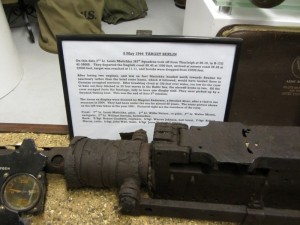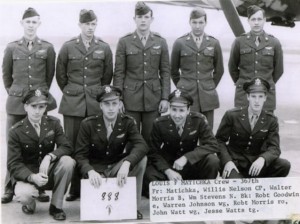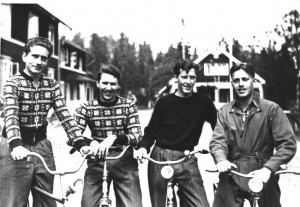15 Jun The Matichka Crew
When my son Johnny and I visited the 306th Bombardment Group Museum at Thurleigh in May 2012 we were immediately drawn to the exhibit of a .50 caliber machine gun that had been pulled from a B-17 that ditched in the Baltic Sea just off the coast of Sweden on May 8, 1944. That was two months after my Dad’s B-17 had force landed on the nearby island of Gotland under similar circumstances. The museum’s owner and director Ralph Franklin told us the amazing story of how the museum had acquired the machine gun.
Then this past month members of two Facebook groups … 306th Bomb Group – First over Germany and American Internees in WWII Sweden … suddenly began posting photos about the Matichka crew and their B-17, the “888.”
8th AF sends bombers to Berlin
Let’s go back nearly seventy years. The 8th AF had just begun their missions into Berlin. The first had been on March 4th. Then on March 6th was the first full large-scale daylight raid to the Nazi capital. Thus began the missions deeper and deeper into Germany.
The crew of the 888 (42-38008)
- Pilot: 2nd Lt. Louis F Matichka
- Co-pilot. 2nd Lt. Willis S Nelson
- Navigator. 2nd Lt. Walter D Morris
- Bombardier/Nose Gunner: 2nd Lt. William D Stevens
- Engineer/Top Turret Gunner: T/Sgt. Robert B Goodwin
- Radio Operator: T/Sgt. Robert T Morris
- Ball Turret Gunner: S/Sgt. Warren H Johnson
- Right Waist Gunner: S/Sgt. John F Watt
- Left Waist Gunner: S/Sgt. Forest B Buford
- Tail Gunner: S/Sgt. Jesse P Jr. Watts
On the morning of May 8, 1944, the 8th AF sent 378 B-17s to Berlin. This was the 306th’s third attempted mission to Berlin in five days. The weather had been the problem, and it still was. Thirty planes left from Thurleigh, but five aborted early on when they were unable to stay in the formation. One of these five planes never even made it back to the base.
At 10:42 that morning was the worst non-combat tragedy in the history of the 306th. The weather was a big factor in the collision of three planes in the formation. It all happened so fast. Other crews saw parts of planes falling through the air; then the three B-17s were gone. In Russell Strong’s First Over Germany, he reported that later it was learned that four men from the three crews did survive.
In the meantime, Lt. Matichka’s plane had moved his position in the squadron and escaped the collision but he was having trouble keeping up. By now it was after 11:00 in the morning. They had lost one or two engines due to flak damage and were low on fuel. The plane headed north, seeking a safe place to land away from enemy territory. They were spotted by the Swedish air defense at two minutes after 12 noon flying over Bergkvara, on the southeastern coast of the country. The Swedish Air Force sent two of their planes to try to lead the crippled plane to the airbase at Kalmar, slightly north of where they were.
View Matichka Crew in a larger map
However, when they broke through the clouds the plane was only 100 feet over water, too low for the crew to bail out, so the pilots ditched in the Baltic Sea about 300 feet out from the little island of Vållö, a community of fishermen, especially eel fishermen. The aircraft broke in two and quickly sank.
According to a newspaper report, the people on the island knew right away that there were problems so they put boats into the water. The crew had managed to inflate two dinghies. One of them with five crew members aboard had nearly reached land when the boat capsized and all were thrown into the water. Three managed by themselves to get ashore but two were unconscious and were being swept out to the sea by the currents. They were saved by local people in the last moment.
Five more crew members on another dinghy in the heavy sea were finally rescued by a local fishing boat. All were taken to Vållö where they were cared for and given dry clothes. No one from the crew was wounded, but they had been in the icy water for nearly an hour. Even the two who had been unconscious recovered completely with the care given them by the local Swedish fishermen and their families.
What a harrowing day it had been!
Crew is interned in Sweden
The crew was interned first at Korsnäs and later at Loka Brunn. Eight of the crew members left Sweden in October and November that year. Two of the crew stayed until 1945 working at Vasterås maintaining the United States aircraft stored there.
As they flew away the crew of the two Swedish planes could see the 888 sinking into the sea. Several unsuccessful attempts were made to locate the wreck. Finally in 1982 it was located at a depth of 40 meters (130 feet.) In the late 1980’s some items from the plane were salvaged including a propeller that is now at Oskarshamn airport.
Now fast forward to the year 2004. A Swedish diver named Magnus Andersson contacted Ralph Franklin at the 306th Museum. He and his team had recovered items from Matichka’s aircraft and he wanted to offer them to the museum! It was no easy task to get them from Sweden to Thurleigh, England. First of all, Ralph had to convince the British authorities that the gun was no longer capable of shooting. All in all, the exhibit includes a .50 calibre machine gun from the left side waist position of the plane, a section of the pilot’s instrument panel, and a pair of binoculars complete with case. You can read Ralph Franklin’s account on the last page of the January 2008 issue of Echoes, the 306th BG newsletter.
Tomas Nilsson is another Swedish diver who, with his brother, explored the grave of the 888 in May of 2006.
Beth Gibson, daughter of the bombardier, shared these details about the name of the plane: “They were in the Mighty Eighth, plane name was “888”, they went into the Baltic on May 8 and it was their eighth and final mission!”
As always, I welcome comments, edits and additions to the story of the Matichka crew. Please comment below. THANKS, Pat
(Also, many thanks to Bo Widfeldt’s “Making for Sweden,” Russell Strong’s “First Over Germany,” Ralph Franklin’s article in the 306th Echoes, Beth Gibson, Karen Cline, and Sue Moyer for their contributions.)
UPDATE: Please read the comment from the son of 306th BG pilot 1st Lt. Dallas L. Jacobs, Jr. He rounds out our story with the history of B-17G 42-38008.
Google





Beth Gibson
Posted at 12:54h, 15 JunePat, love it, what a great writer you are!
Pat DiGeorge
Posted at 13:23h, 15 JuneThanks. I had a lot of help!
Christopher L. Jacobs
Posted at 15:14h, 15 JuneHello Pat:
Here’s some background data for your research: My father, 1stLt. Dallas L. Jacobs, Jr., piloted B-17G 42-38008 on 4 missions beginning 29Jan44. It was his crew’s assigned aircraft until a propeller from an Me 109 downed by the tail gunner cut through left wing during the last mission on 25Feb44. 008V had a short but auspicious time with my father’s crew. In 4 missions they downed 3 enemy aircraft. After 008V was repaired it was assigned to Lt. Matichka’s crew.
Best regards,
Chris Jacobs
407-443-9153
Sue Moyer
Posted at 18:31h, 15 JuneFantastic Pat. This should be submitted to the 8th AF News!
Pat DiGeorge
Posted at 19:01h, 15 JuneThanks, Chris. Did your Dad’s crew name it the “888”?
Lissa Stevens Terpening
Posted at 21:16h, 15 JuneHow lovely..great article..especially since my father Wm. Stevens is in two of the pictures.. WOW…so cool
Thanks since tomorrow is “Father’s Day”
Lissa( Beth Gibson’s sister)
Christopher L. Jacobs
Posted at 22:00h, 15 JuneI’ve read somewhere that Matichka’s crew named it for that mission: 008V + 8 May 44 + 8th AF. My dad once told me that few of the aircraft he flew were named. Crew and aircraft attrition made it impractical in his opinion. He flew 25 missions in 13 different aircraft.
Pat DiGeorge
Posted at 16:46h, 16 JuneLisa and Beth … what I keep thinking about is how terrified they must have been. Did your Dad ever talk about seeing the three planes collide? Then just a short time later they have to use what they learned in their lesson on what to do if you have to ditch your B-17. And then the sea is so cold and choppy they can hardly get to shore. What did he say about that day?
Barbara Ann Davis
Posted at 04:54h, 18 JuneGreat article Pat! Love reading stories of heroes and there were a lot of heroes here!!!
Irene Svenonius
Posted at 13:00h, 15 JulyThank you for an interesting article! My grandfather, Ivar Lindstrom, was one of the eel fishers who rescued the crew. He got a whistle blower from one in the crew, which is still in the house! However, I grew up with grandpa telling the story about how they managed to save all the lives that day. He also always said that the crew thought they were in Norway. That’s why they sank the plane at the deepest spot, so the German occupants of Norway wouldn’t get anything from it. The fishermen had to show a swedish flag to convince the crew they were safe.
Members of the crew came back visiting the island before travelling back to the US. I think I have a couple of pictures!
Sincerely
Pat DiGeorge
Posted at 14:48h, 15 JulyIrene, thank you so much for your comment! What an excellent addition to my story. Are you on Facebook? If you are, please join our group “American Internees in WWII Sweden.” I’m going to post this there.
lawrence kandel
Posted at 07:32h, 22 MarchVery proud to say Lt. Louis Matichka was my wife’s uncle and he was the pilot=He was one of the most intelligent and knowledgeable people I have ever known– and we would sit for hours discussing “things” be they world shattering or very minor issues-, he was a gentle soul and is always missed.-
Ann Buford-Stephenson
Posted at 18:57h, 29 DecemberI’m very happy to have found this article! Wonderful information that fills out the stories I heard from my father. He was a member of this crew – S/Sgt Forest B Buford. We have some photos he took during his internment in Sweden. I’d be happy to share them with your group. He remembered every detail of the day their plane ditched. We were contacted in 2002 by a Swedish researcher who notified Dad that they had located their plane and were hoping to salvage parts for a museum. Do you have any information on that? Thanks so much.
Pat DiGeorge
Posted at 07:44h, 30 DecemberYes, Ann. In 2012, I saw the exhibit of your father’s plane at the 306th Bombardment Group Museum in England. See the photo at the top of this article. If you are on Facebook, please join our group American Internees in WWII Sweden. Do a quick search and you will find a lot more information about this crew. Thank you so much for checking in. Pat DiGeorge